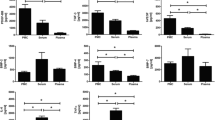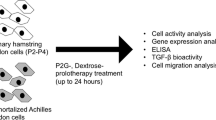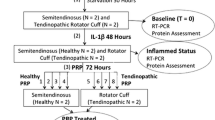Abstract
Little is know about the pathophysiology of acute and degenerative tendon injuries. Although most lesions are uncomplicated, treatment is long and unsatisfactory in a considerable number of cases. Besides the common growth factors that were shown to be relevant for tendon integrity more recently protection against oxidative stress was shown to promote tendon healing. To improve tendon regeneration, many have advocated the use of platelet-rich plasma (PRP), a thrombocyte concentrate that can serve as an autologous source of growth factors. In this study, we investigated the effect of platelet-released growth factors (PRGF) on tenocytes. Tenocytes were isolated from the Achilles tendon of postnatal rats. Tenocyte cell cultures were stimulated with PRGF. We used a CyQuant assay and WST assay to analyse tendon cell growth and viability in different concentrations of PRGF. Migration and proliferation of cells grown in PRGF were assessed by a scratch test. A dual-luciferase assay was used to demonstrate the activation of the anti-oxidant response element (ARE) in tenocytes. A positive effect of PRGF could be shown on tendon cell growth and migratory capacity. PRGF activated the Nrf2–ARE pathway in a dose-dependent manner. Here, we provide evidence of a biological effect of PRGF on tenocytes by the promotion of tenocyte growth and activation of the Nrf2–ARE pathway. This is a novel aspect of the action of platelet concentrates on tendon growth.




Similar content being viewed by others
References
Anitua E, Andia I, Sanchez M, Azofra J, del Mar Zalduendo M, de la Fuente M, Nurden P, Nurden AT (2005) Autologous preparations rich in growth factors promote proliferation and induce VEGF and HGF production by human tendon cells in culture. J Orthop Res 23:281–286
Aspenberg P, Virchenko O (2004) Platelet concentrate injection improves Achilles tendon repair in rats. Acta Orthop Scand 75:93–99
Bielecki TM, Gazdzik TS, Arendt J, Szczepanski T, Krol W, Wielkoszynski T (2007) Antibacterial effect of autologous platelet gel enriched with growth factors and other active substances: an in vitro study. J Bone Joint Surg Br 89:417–420
Chan K, Kan YW (1999) Nrf2 is essential for protection against acute pulmonary injury in mice. Proc Natl Acad Sci USA 96:12731–12736
Cunningham BW, Sefter JC, Hu N, McAfee PC (2010) Autologous growth factors versus autogenous graft for anterior cervical interbody fusion: an in vivo caprine model. J Neurosurg Spine 13:216–223
de Vos RJ, Weir A, Tol JL, Verhaar JA, Weinans H, van Schie HT (2010) No effects of PRP on ultrasonographic tendon structure and neovascularisation in chronic midportion Achilles tendinopathy. Br J Sports Med [Epub ahead of print]
Docheva D, Hunziker EB, Fassler R, Brandau O (2005) Tenomodulin is necessary for tenocyte proliferation and tendon maturation. Mol Cell Biol 25:699–705
Froum SJ, Wallace SS, Tarnow DP, Cho SC (2002) Effect of platelet-rich plasma on bone growth and osseointegration in human maxillary sinus grafts: three bilateral case reports. Int J Periodontics Restorative Dent 22:45–53
Fuerst G, Gruber R, Tangl S, Sanroman F, Watzek G (2004) Effects of fibrin sealant protein concentrate with and without platelet-released growth factors on bony healing of cortical mandibular defects. An experimental study in minipigs. Clin Oral Implants Res 15:301–307
Goel DP, Chan D, Watson K, Mohtadi N (2009) Safety and hospital costs of Achilles tendon surgery: the serendipitous impact of a randomized clinical trial. Can J Surg 52:467–472
Graziani F, Cei S, Ducci F, Giuca MR, Donos N, Gabriele M (2005) In vitro effects of different concentration of PRP on primary bone and gingival cell lines. Preliminary results. Minerva Stomatol 54:15–22
Huang HC, Nguyen T, Pickett CB (2000) Regulation of the antioxidant response element by protein kinase C-mediated phosphorylation of NF-E2-related factor 2. Proc Natl Acad Sci USA 97:12475–12480
Ishii T, Itoh K, Takahashi S, Sato H, Yanagawa T, Katoh Y, Bannai S, Yamamoto M (2000) Transcription factor Nrf2 coordinately regulates a group of oxidative stress-inducible genes in macrophages. J Biol Chem 275:16023–16029
Jin W, Wang H, Ji Y, Hu Q, Yan W, Chen G, Yin H (2008) Increased intestinal inflammatory response and gut barrier dysfunction in Nrf2-deficient mice after traumatic brain injury. Cytokine 44:135–140
Kark LR, Karp JM, Davies JE (2006) Platelet releasate increases the proliferation and migration of bone marrow-derived cells cultured under osteogenic conditions. Clin Oral Implants Res 17:321–327
Khan KM, Maffulli N, Coleman BD, Cook JL, Taunton JE (1998) Patellar tendinopathy: some aspects of basic science and clinical management. Br J Sports Med 32:346–355
Kimura N, Shukunami C, Hakuno D, Yoshioka M, Miura S, Docheva D, Kimura T, Okada Y, Matsumura G, Shin’oka T, Yozu R, Kobayashi J, Ishibashi-Ueda H, Hiraki Y, Fukuda K (2008) Local tenomodulin absence, angiogenesis, and matrix metalloproteinase activation are associated with the rupture of the chordae tendineae cordis. Circulation 118:1737–1747
Kon E, Buda R, Filardo G, Di Martino A, Timoncini A, Cenacchi A, Fornasari PM, Giannini S, Marcacci M (2010) Platelet-rich plasma: intra-articular knee injections produced favorable results on degenerative cartilage lesions. Knee Surg Sports Traumatol Arthrosc 18:472–479
Leadbetter WB, Mooar PA, Lane GJ, Lee SJ (1992) The surgical treatment of tendinitis. Clinical rationale and biologic basis. Clin Sports Med 11:679–712
Lee JM, Li J, Johnson DA, Stein TD, Kraft AD, Calkins MJ, Jakel RJ, Johnson JA (2005) Nrf2, a multi-organ protector? FASEB J 19:1061–1066
Lippross S, Loibl M, Hoppe S, Meury T Benneker L, Alini M, Verrier S (2011) Platelet released growth factors boost expansion of bone marrow derived CD34+ and CD133+ endothelial progenitor cells for autologous grafting. Platelets (in press)
Lopez-Vidriero E, Goulding KA, Simon DA, Sanchez M, Johnson DH (2010) The use of platelet-rich plasma in arthroscopy and sports medicine: optimizing the healing environment. Arthroscopy 26:269–278
Maffulli N, Khan KM, Puddu G (1998) Overuse tendon conditions: time to change a confusing terminology. Arthroscopy 14:840–843
Majewski M, Ochsner PE, Liu F, Fluckiger R, Evans CH (2009) Accelerated healing of the rat Achilles tendon in response to autologous conditioned serum. Am J Sports Med 37:2117–2125
Marx RE, Carlson ER, Eichstaedt RM, Schimmele SR, Strauss JE, Georgeff KR (1998) Platelet-rich plasma: growth factor enhancement for bone grafts. Oral Surg Oral Med Oral Pathol Oral Radiol Endod 85:638–646
Mirabet V, Solves P, Minana MD, Encabo A, Carbonell-Uberos F, Blanquer A, Roig R (2008) Human platelet lysate enhances the proliferative activity of cultured human fibroblast-like cells from different tissues. Cell Tissue Bank 9:1–10
Okamoto N, Kushida T, Oe K, Umeda M, Ikehara S, Iida H (2010) Treating Achilles tendon rupture in rats with bone-marrow-cell transplantation therapy. J Bone Joint Surg Am 92:2776–2784
Park HB, Hah YS, Yang JW, Nam JB, Cho SH, Jeong ST (2010) Antiapoptotic effects of anthocyanins on rotator cuff tenofibroblasts. J Orthop Res 28:1162–1169
Schepull T, Kvist J, Norrman H, Trinks M, Berlin G, Aspenberg P (2011) Autologous platelets have no effect on the healing of human Achilles tendon ruptures: a randomized single-blind study. Am J Sports Med 39:38–47
Schulze-Tanzil G, Mobasheri A, Clegg PD, Sendzik J, John T, Shakibaei M (2004) Cultivation of human tenocytes in high-density culture. Histochem Cell Biol 122:219–228
Shiras A, Chettiar ST, Shepal V, Rajendran G, Prasad GR, Shastry P (2007) Spontaneous transformation of human adult nontumorigenic stem cells to cancer stem cells is driven by genomic instability in a human model of glioblastoma. Stem Cells 25:1478–1489
Shukunami C, Oshima Y, Hiraki Y (2001) Molecular cloning of tenomodulin, a novel chondromodulin-I related gene. Biochem Biophys Res Commun 280:1323–1327
Slapnicka J, Fassmann A, Strasak L, Augustin P, Vanek J (2008) Effects of activated and nonactivated platelet-rich plasma on proliferation of human osteoblasts in vitro. J Oral Maxillofac Surg 66:297–301
Stoll C, John T, Endres M, Rosen C, Kaps C, Kohl B, Sittinger M, Ertel W, Schulze-Tanzil G (2010) Extracellular matrix expression of human tenocytes in three-dimensional air-liquid and PLGA cultures compared with tendon tissue: implications for tendon tissue engineering. J Orthop Res 28:1170–1177
Stone D, Green C, Rao U, Aizawa H, Yamaji T, Niyibizi C, Carlin G, Woo SL (1999) Cytokine-induced tendinitis: a preliminary study in rabbits. J Orthop Res 17:168–177
Tohidnezhad M, Varoga D, Wruck CJ, Seekamp A, Podschun R, Pufe T, Lippross S (2011) Thrombocytes are effectors of the innate immune system releasing human beta defensin-3. Injury [Epub ahead of print]
van den Dolder J, Mooren R, Vloon AP, Stoelinga PJ, Jansen JA (2006) Platelet-rich plasma: quantification of growth factor levels and the effect on growth and differentiation of rat bone marrow cells. Tissue Eng 12:3067–3073
Varoga D, Wruck CJ, Tohidnezhad M, Brandenburg L, Paulsen F, Mentlein R, Seekamp A, Besch L, Pufe T (2009) Osteoblasts participate in the innate immunity of the bone by producing human beta defensin-3. Histochem Cell Biol 131:207–218
Virchenko O, Aspenberg P (2006) How can one platelet injection after tendon injury lead to a stronger tendon after 4 weeks? Interplay between early regeneration and mechanical stimulation. Acta Orthop 77:806–812
Visser LC, Arnoczky SP, Caballero O, Kern A, Ratcliffe A, Gardner KL (2010) Growth factor-rich plasma increases tendon cell proliferation and matrix synthesis on a synthetic scaffold: an in vitro study. Tissue Eng Part A 16:1021–1029
Wruck CJ, Claussen M, Fuhrmann G, Römer L, Schulz A, Pufe T, Waetzig V, Peipp M, Herdegen T, Götz ME (2007) Luteolin protects rat PC12 and C6 cells against MPP+ induced toxicity via an ERK dependent Keap1-Nrf2-ARE pathway. J Neural Transm Suppl(72):57–67
Wruck C, Fragoulis A, Gurzynski A, Brandenburg L, Kan YW, Hassenpflug J, Freitag-Wolf S, Varoga D, Lippross S, Pufe T (2011) Role of oxidative strss in rheumatoid arthritis: Insights from the Nrf-2 knockout mice. Ann Rheum Dis [epub ahead of print Dec 2010]
Yao L, Bestwick CS, Bestwick LA, Maffulli N, Aspden RM (2006) Phenotypic drift in human tenocyte culture. Tissue Eng 12:1843–1849
Yuan J, Murrell GA, Trickett A, Wang MX (2003) Involvement of cytochrome c release and caspase-3 activation in the oxidative stress-induced apoptosis in human tendon fibroblasts. Biochim Biophys Acta 1641:35–41
Zhang F, Liu H, Stile F, Lei MP, Pang Y, Oswald TM, Beck J, Dorsett-Martin W, Lineaweaver WC (2003) Effect of vascular endothelial growth factor on rat Achilles tendon healing. Plast Reconstr Surg 112:1613–1619
Zhao J, Moore AN, Redell JB, Dash PK (2007) Enhancing expression of Nrf2-driven genes protects the blood brain barrier after brain injury. J Neurosci 27:10240–10248
Conflict of interest
All authors have no conflict of interest.
Author information
Authors and Affiliations
Corresponding author
Additional information
M. Tohidnezhad, D. Varoga, T. Pufe, and S. Lippross contributed equally to the work.
Electronic supplementary material
Below is the link to the electronic supplementary material.
Supplementary Figure 1
Tenocytes migrating out of the Achilles tendon explant. (TIFF 658 kb)
Movie 1a Scratch test. Cells were seeded on a thermanox-slide in PRGF 10% (movie 1a); time interval observed was 12 h. Scratch test revealed migration of tenocytes due to PRGF.
Movie 1b Scratch test. Cells were seeded on a thermanox-slide in control (movie 1b); time interval observed was 12 h. Scratch test revealed migration of tenocytes due to PRGF.
Rights and permissions
About this article
Cite this article
Tohidnezhad, M., Varoga, D., Wruck, C.J. et al. Platelet-released growth factors can accelerate tenocyte proliferation and activate the anti-oxidant response element. Histochem Cell Biol 135, 453–460 (2011). https://doi.org/10.1007/s00418-011-0808-0
Accepted:
Published:
Issue Date:
DOI: https://doi.org/10.1007/s00418-011-0808-0




